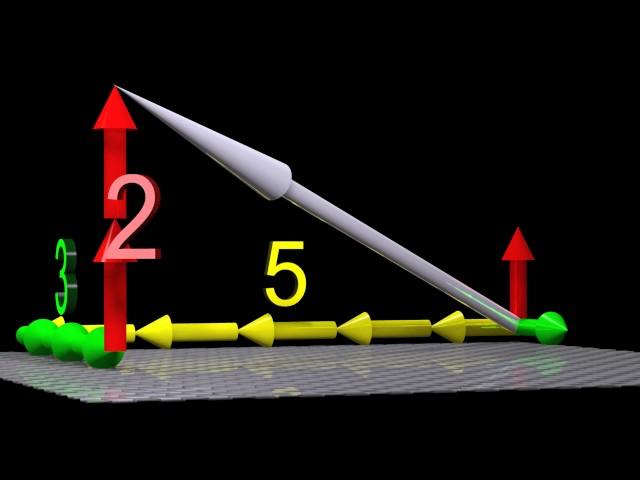
Tensors Explained Intuitively: Covariant, Contravariant, Rank
Комментарии:

To see subtitles in other languages: Click on the gear symbol under the video, then click on "subtitles." Then select the language (You may need to scroll up and down to see all the languages available).
--To change subtitle appearance: Scroll to the top of the language selection window and click "options." In the options window you can, for example, choose a different font color and background color, and set the "background opacity" to 100% to help make the subtitles more readable.
--To turn the subtitles "on" or "off" altogether: Click the "CC" button under the video.
--If you believe that the translation in the subtitles can be improved, please send me an email.

What do you mean?????
Can you rclaindo.ething pleZd
Yorvif isa co.rye chaos

Great video as usual, I hope you clear up a simple problem with me, at the beginning of the video. I notice that the projection component of the white vector in the direction of the yellow base vector, after changing the base vectors, must be -4, not 4. Is my point valid? Or , when are project the vector, the projection must be parallel to the red base, and therefore it fell in the positive part
Ответить
It is the most appropriate discription.
Ответить
Oss!
Ответить
Brilliant video but I need a bit of help if anyone is kind enough. Isnt the dot product invariant? When the video says that increasing the basis vectors also increases the dot product (as an example of covariance), isnt the dot product able to be thought of as the projection of V on the respective basis vector? Surely as the angle has to be 90°, the dot product would half if you doubled the basis bector for say x? Thanks in advance
Ответить
Ok, after months of thinking on this, I have an explanation of covariant vs contravariant that no one has ever uttered, as far as I know. Here goes. Hold my beer!
———
You combine contravariant (components times their regular basis vectors) tip to tail to reach the tip of the vector you're defining.
But with covariant, you combine (covariant components times their dual basis vectors) tip to tail to get to the tip of the vector you're definging.
Why does no one explain it like this?
But my question is how is covarant components of dual basis vectors relate to the dot product? Please correct me if I'm wrong on the following...
DOT PRODUCT: A (vector) dot B (vector) = a scalar quantity
CONTRAVARIANT: described by the combination of contravariant (components times regular basis vectors) added tip to tail of
A (vector) dot B (vector).
COVARIANT: described by the combination of covariant (components times dual basis vectors) added tip to tail of
A prime (vector) dot B prime (vector).
QUESTION:
If we dot product A prime (vector) with B prime (vector), does that scalar quantity equal
A lower 1 prime times e upper 1 prime PLUS A lower 2 prime times e upper 2 prime?
If so, arent we then saying that a scalr is equal to a vector???

I don’t understand covariant components. I see no method of obtaining the vector length by combination of the components. And no method is explained like it is with the contravariant. From what I see right now, it doesn’t seem that covariant components are really components at all because components add together to create something and these numbers, do not combine any real sense to point to the tip of a vector
Ответить
THE COMPONENTS ARE NO ARBITRARY LIKE HERE USUALLY THEY ARE PERPENDICULAR TO EACH OTHER
Ответить
IS NO CLEAR BECAUSE THERE IS NO AXIS NO COVARIANT AND CONTRAVARIANT BASIS DERIV. AND NABLA.
Ответить
Это бред сумасшедшего
Ответить
Intuitive? Muah!
Every time I started to assimilate a comcept raised that idiotic music cut in and completely derailed my thought.
I know dot product and basis vector but if you only have a vague idea of these concepts then your explanation is meaningless. Even so Iost what you point was. As for an intuitive explanation of tensors! You make me laugh.
Ha Ha Ha .Ha Ha HA HA HA not even close

The music is throwing me off. Thank you tho
Ответить
The music used is annoying and distracting
Ответить
Your combination of graphics, content and music is otherworldly 😊
Ответить
…as someone who does not know math very well…all I’m seeing is taking arbitrary representations of different vectors and finding different ways to mash them together and then giving it a name…what is the point?
Ответить
We started learning about tensors about month ago... Since then I was completely list... This video has given me a hope to catch up again!
Seriously great animation interperation as always :D

I've never seen an explanation of tensors that I could understant, thank you! If the family of base vectors is orthonormal, does that mean that the covariant and contravariant components of the tensor in that base are the same? Since the coordinates of a vector V in such a base (e1, e2... en) are given by <V,ei> this should be the case but maybe i'm missing something
Ответить
Why the music? It damages the quality of the video. There is no problem with no music at all.
Ответить
The background music you have chosen is too rich and emotional, it distracts from the presentation.
Ответить
Let's see Paul Allen's explanation of Tensors
Ответить
Content is excellent. The background music is distracting.
Ответить
This is a very good explanation, but it has left me with even more questions:
These contra-/covariant components of a vector are defined with respect to certain basis vectors.
But then what are "contra-/covariant basis vectors"? (compared to "contravariant basis vectors")
I assume the basis vectors used in this video are "covariant basis vectors"?
How do I interpret "contravariant basis vectors"?

Is this video implying that covectors and vectors are the same object, just represented differently? In tensor algebra contexts I've seen the covector also represented as a function that takes vector inputs, but vectors stayed as just vectors.
Ответить
Much helpful
Ответить
What is meant by "Combination of Vectors or components of vectors"? product...?..?
Ответить
This video is a precious resource for novices at tensor calculus
Ответить
Superb presentation and graphics . Dot product has been always been a mystery to me .
Ответить
I wonder if these videos are scripted or actually handcrafted. Nevertheless, incredible content.
Ответить
BGM is annoying...
Ответить
i feel like throwing up this video is making me so queasy
Ответить
The explanations are good, but I find the music to be extremely distracting. It forces its way in, making me to pay attention to two things at once, which I can't do. This is especially frustrating when the music crescendos. I try to ignore it, but it's difficult because it's there demanding my attention. Again, this is especially the case when the tempo changes or when it crescendos. IMO, it would be better to leave it out. It adds nothing to the explanation. It may seem like a nice idea, but I don't think it works. After all: professors don't typically lecture with the radio playing in the background.
Ответить
In geometric algebra, you add another the rule that says T[i,i] = basis[i] dot basis[i], and then a whole bunch of interesting stuff falls out like complex numbers and quaternions
Ответить
Please stop with the music !! It’s very very irritating !!!
Ответить
El primer problema que se planteo dirac fue cuanto tiene que valer α y β para que esto sea verdad y se cumpla esta igualdad.
E=±√(β²+α²)=βx+αy
(αx+βy)×(αx+βy)=x²+y²
(αx+βy)×(αx+βy)=(β²x²+α²y²+2αβxy)
5=±√(4²+3²)=0,8×4+0,6×3
(O,8×4+0,6×3)×(0,8×4+0,6×3)=25
(0,6×3)×(0,8×4+0,6×3)=3²
(O,8×4)×(0,8×4+0,6×3)=4²
0,8²×4²+0,6²×3²+2×0,6×0,8×3×4=25
Asi que como no sabia el valor β y α creyo que era imposible que esa igualdad se cumpliera. E impuso que α² y β² tendria que ser 1 y que beta o alfa tendria que ser 0 para quitar este termino 2αβxy para poder cumplir esa igualdad.
α²=β²=1 y βα=0
0,6²+0,8²=1 y 0,6*0,8=0,48
Lo que hizo dirac fue buscarle una soluciòn por medio de matrices a esta ecuaciòn:
E=±√(m²*C⁴+p²*c²)=βmc²+ (αp)*c
Y transformar las matrices de pauli que en aquella epoca no eran compatibles con la teoria relativista, por que se basaban en la fisica clásica de newton.
Donde β α beta y alfa pareciera los angulos de un triangulo.
Cateto opuesto² + cateto ady² = hipotenusa²
Donde m²*C⁴ seria el cateto adyacente p²*c² seria el cateto opuesto y E² la hipotenusa.
m²*C⁴+p²*c²=E²
Ahora un Triangulo rectangulo con catetos 3 y 4 y hipotenusa 5 para simplicar el problema.
Podemos reprentar a 4 como m*c^2 a 3 como pc y 5 como E.
Cat. ady² =16 cat opuesto²=9 hipotenusa²=25
5=±√(16+9) equivale E=±√(m²*C⁴+p²*c²)
(β*4+ α*3=5)=±(0,8*4+0,6*3=5) de la raiz cuadrada se obtienenen dos soluciones iguales de signo opuesto 5 y -5
β=Cos=Cat ady/ hip=4/5=0,8
α=Sen=C.Opues/hip=3/5=0,6
Esta se podria considerar como una soluciòn, pero el problema es que existen mas soluciones se diferencia de algunas soluciones en que son triangulos semejantes.
Dos triángulos son semejantes cuando tienen sus ángulos homólogos iguales. (Cos16/25=3,2/5 y Sen9/25=1,8/5)y sus lados homólogos proporcionales(1,8*5 ,3.2*5 y 5*5).
E^2=m^2c^4+p^2c^2 ≡ E=βm^2+αpc
E y E^2 son equivalentes Sus lados son proporcionales y angulos iguales.
Equivalencia de α y β
5^2+100^2=125
Si multiplica este termino por 4:
(5/√(5^2+10^2)*5)*4=10/√(5^2+10^2)*10 es
cuatro veces mayor como
(5^2*4=100)=(25*4=100)
Ahora si se divide entre 4 este otro termino:
(10/√(5^2+10^2)*10)/4= 5/√(5^2+10^2)*5 es 4 veces menor, como 100/4=25
Ahora si sumo ambos terminos me da la E:
5/√(5^2+10^2)*5+10/√(5^2+10^2)*10=E
Como
100+25=125. es E^2
Y si elevo todo este termino al cuadrado
(5/√(5^2+10^2)*5+10/√(5^2+10^2)*10)^2 me da E^2 125
Como inversamente la raiz de (125)^1/2 me da E.
E=(5/√(5^2+10^2)*5+10/√(5^2+10^2)*10)
4^2+3^2=5^2
16+9=25
(9)^1/2/(25)^1/2=(1,8)^1/2/(5)^1/2
16^1/2/25^1/2=3,2^1/2/5^1/2
E y E^2. Son triangulos semejantes sus angulos son iguales y sus lados proporcionales:
E^2=m^2c^4+p^2c^2 ≡ E=m^2*pc
≡ significa que son equivalentes o proporcionales
16/25=3,2/5 y 9/25=1,8/5
16/25+9/25=1
3,2/5+1,8/5=1
16/25=3,2/5 y 9/25=1,8/5
Si sus angulos son iguales su coeficiente de correlacion es 1

El primer problema que se planteo dirac fue cuanto tiene que valer α y β para que esto sea verdad y se cumpla esta igualdad.
E=±√(β²+α²)=βx+αy
(αx+βy)×(αx+βy)=x²+y²
(αx+βy)×(αx+βy)=(β²x²+α²y²+2αβxy)
5=±√(4²+3²)=0,8×4+0,6×3
(O,8×4+0,6×3)×(0,8×4+0,6×3)=25
(0,6×3)×(0,8×4+0,6×3)=3²
(O,8×4)×(0,8×4+0,6×3)=4²
0,8²×4²+0,6²×3²+2×0,6×0,8×3×4=25
Asi que como no sabia el valor β y α creyo que era imposible que esa igualdad se cumpliera. E impuso que α² y β² tendria que ser 1 y que beta o alfa tendria que ser 0 para quitar este termino 2αβxy y poder cumplir esa igualdad.
α²=β²=1 y βα=0
0,6²+0,8²=1 y 0,6*0,8=0,48
Lo que hizo dirac fue buscarle una soluciòn por medio de matrices a esta ecuaciòn:
E=±√(m²*C⁴+p²*c²)=βmc²+ (αp)*c
Y transformar las matrices de pauli que en aquella epoca no eran compatibles con la teoria relativista, por que se basaban en la fisica clásica de newton.
Donde β α beta y alfa pareciera los angulos de un triangulo.
Cateto opuesto² + cateto ady² = hipotenusa²
Donde m²*C⁴ seria el cateto adyacente p²*c² seria el cateto opuesto y E² la hipotenusa.
m²*C⁴+p²*c²=E²
Ahora un Triangulo rectangulo con catetos 3 y 4 y hipotenusa 5 para simplicar el problema.
Podemos reprentar a 4 como m*c^2 a 3 como pc y 5 como E.
Cat. ady² =16 cat opuesto²=9 hipotenusa²=25
5=±√(16+9) equivale E=±√(m²*C⁴+p²*c²)
(β*4+ α*3=5)=±(0,8*4+0,6*3=5) de la raiz cuadrada se obtienenen dos soluciones iguales de signo opuesto 5 y -5
β=Cos=Cat ady/ hip=4/5=0,8
α=Sen=C.Opues/hip=3/5=0,6
Esta se podria considerar como una soluciòn, pero el problema es que existen mas soluciones se diferencia de algunas soluciones en que son triangulos semejantes.
Dos triángulos son semejantes cuando tienen sus ángulos homólogos iguales. (Cos16/25=3,2/5 y Sen9/25=1,8/5)y sus lados homólogos proporcionales(1,8*5 ,3.2*5 y 5*5).
E^2=m^2c^4+p^2c^2 ≡ E=βm^2+αpc
E y E^2 son equivalentes Sus lados son proporcionales y angulos iguales.
Equivalencia de α y β
5^2+100^2=125
Si multiplica este termino por 4:
(5/√(5^2+10^2)*5)*4=10/√(5^2+10^2)*10 es
cuatro veces mayor como
(5^2*4=100)=(25*4=100)
Ahora si se divide entre 4 este otro termino:
(10/√(5^2+10^2)*10)/4= 5/√(5^2+10^2)*5 es 4 veces menor, como 100/4=25
Ahora si sumo ambos terminos me da la E:
5/√(5^2+10^2)*5+10/√(5^2+10^2)*10=E
Como
100+25=125. es E^2
Y si elevo todo este termino al cuadrado
(5/√(5^2+10^2)*5+10/√(5^2+10^2)*10)^2 me da E^2 125
Como inversamente la raiz de (125)^1/2 me da E.
E=(5/√(5^2+10^2)*5+10/√(5^2+10^2)*10)
4^2+3^2=5^2
16+9=25
(9)^1/2/(25)^1/2=(1,8)^1/2/(5)^1/2
16^1/2/25^1/2=3,2^1/2/5^1/2
E y E^2. Son triangulos semejantes sus angulos son iguales y sus lados proporcionales:
E^2=m^2c^4+p^2c^2 ≡ E=m^2*pc
≡ significa que son equivalentes o proporcionales
16/25=3,2/5 y 9/25=1,8/5
16/25+9/25=1
3,2/5+1,8/5=1
16/25=3,2/5 y 9/25=1,8/5
Si sus angulos son iguales su coeficiente de correlacion es 1

El primer problema que se planteo dirac fue cuanto tiene que valer α y β para que esto sea verdad y se cumpla esta igualdad.
E=±√(β²+α²)=βx+αy
(αx+βy)×(αx+βy)=x²+y²
(αx+βy)×(αx+βy)=(β²x²+α²y²+2αβxy)
5=±√(4²+3²)=0,8×4+0,6×3
(O,8×4+0,6×3)×(0,8×4+0,6×3)=25
(0,6×3)×(0,8×4+0,6×3)=3²
(O,8×4)×(0,8×4+0,6×3)=4²
0,8²×4²+0,6²×3²+2×0,6×0,8×3×4=25
Asi que como no sabia el valor β y α creyo que era imposible que esa igualdad se cumpliera. E impuso que α² y β² tendria que ser 1 y que beta o alfa tendria que ser 0 para quitar este termino 2αβxy y poder cumplir esa igualdad.
α²=β²=1 y βα=0
0,6²+0,8²=1 y 0,6*0,8=0,48
Lo que hizo dirac fue buscarle una soluciòn por medio de matrices a esta ecuaciòn:
E=±√(m²*C⁴+p²*c²)=βmc²+ (αp)*c
Y transformar las matrices de pauli que en aquella epoca no eran compatibles con la teoria relativista, por que se basaban en la fisica clásica de newton.
Donde β α beta y alfa pareciera los angulos de un triangulo.
Cateto opuesto² + cateto ady² = hipotenusa²
Donde m²*C⁴ seria el cateto adyacente p²*c² seria el cateto opuesto y E² la hipotenusa.
m²*C⁴+p²*c²=E²
Ahora un Triangulo rectangulo con catetos 3 y 4 y hipotenusa 5 para simplicar el problema.
Podemos reprentar a 4 como m*c^2 a 3 como pc y 5 como E.
Cat. ady² =16 cat opuesto²=9 hipotenusa²=25
5=±√(16+9) equivale E=±√(m²*C⁴+p²*c²)
(β*4+ α*3=5)=±(0,8*4+0,6*3=5) de la raiz cuadrada se obtienenen dos soluciones iguales de signo opuesto 5 y -5
β=Cos=Cat ady/ hip=4/5=0,8
α=Sen=C.Opues/hip=3/5=0,6
Esta se podria considerar como una soluciòn, pero el problema es que existen mas soluciones se diferencia de algunas soluciones en que son triangulos semejantes.
Dos triángulos son semejantes cuando tienen sus ángulos homólogos iguales. (Cos16/25=3,2/5 y Sen9/25=1,8/5)y sus lados homólogos proporcionales(1,8*5 ,3.2*5 y 5*5).
E^2=m^2c^4+p^2c^2 ≡ E=βm^2+αpc
E y E^2 son equivalentes Sus lados son proporcionales y angulos iguales.
Equivalencia de α y β
5^2+100^2=125
Si multiplica este termino por 4:
(5/√(5^2+10^2)*5)*4=10/√(5^2+10^2)*10 es
cuatro veces mayor como
(5^2*4=100)=(25*4=100)
Ahora si se divide entre 4 este otro termino:
(10/√(5^2+10^2)*10)/4= 5/√(5^2+10^2)*5 es 4 veces menor, como 100/4=25
Ahora si sumo ambos terminos me da la E:
5/√(5^2+10^2)*5+10/√(5^2+10^2)*10=E
Como
100+25=125. es E^2
Y si elevo todo este termino al cuadrado
(5/√(5^2+10^2)*5+10/√(5^2+10^2)*10)^2 me da E^2 125
Como inversamente la raiz de (125)^1/2 me da E.
E=(5/√(5^2+10^2)*5+10/√(5^2+10^2)*10)
4^2+3^2=5^2
16+9=25
(9)^1/2/(25)^1/2=(1,8)^1/2/(5)^1/2
16^1/2/25^1/2=3,2^1/2/5^1/2
E y E^2. Son triangulos semejantes sus angulos son iguales y sus lados proporcionales:
E^2=m^2c^4+p^2c^2 ≡ E=m^2*pc
≡ significa que son equivalentes o proporcionales
16/25=3,2/5 y 9/25=1,8/5
16/25+9/25=1
3,2/5+1,8/5=1
16/25=3,2/5 y 9/25=1,8/5
Si sus angulos son iguales su coeficiente de correlacion es 1

Hi why not take/turn off the music? it disturbs me a lot.
Ответить
Bruh whats up with that music
Ответить
Grazie
Ответить
Cette vidéo m'a permis de comprendre pourquoi les noms de covariant et contravariant. Mais j'ai du ressortir la formule du produit scalaire pour comprendre. Si on a un vecteur de base i et un vecteur A qui fait un angle alpha avec i alors le produit scalaire est (avec les lettres représentant la norme des vecteurs) : A * i * cos(alpha) si on fait un changement de coordonnées I=2i alors le nouveau produit scalaire est A * I * cos(alpha) ou A * 2i * cos(alpha) donc on a doublé le produit scalaire qui est la coordonnée covariante. Mais je ne vois pas comment l'animation montre cela, comment elle intègre la formule du produit scalaire. L'animation fait disparaître les projections orthogonales des vecteurs au moment où on double la longueur des vecteurs de base avouant ainsi que la représentation ne représente rien. On ne peut comprendre la vidéo que si l'on a intégré la formule du produit scalaire. Donc la vidéo ne donne pas une représentation intuitive car on doit faire référence au cerveau gauche pour aller chercher la formule du produit scalaire.
Ответить
Your content is good and simple but the background music in almost all of your videos are annoying.
Ответить
Omg, this channel is a Gold mine for upper division classes. Again thank you so much. You’re helping me with Quantum mechanics and Electrodynamics! Specially as a nonverbal visual learner this really helps!
Ответить
Excellent work.
Ответить
Very well made 😀
Ответить
What exactly does a "combination of basis vectors" in a tensor mean? I can understand that associating a number to a single basis vector gives some sense of "action in a direction," as in the case of a vector. But what does it mean to associate a number to a combination of two basis vectors, for instance? Any real-world examples would be helpful.
Ответить
Many thanks for this wonderful video/explanation 🙏
Ответить







![Windows 11 - Fix No Sound Output Problem | All Audio Problems [Solved] Windows 11 - Fix No Sound Output Problem | All Audio Problems [Solved]](https://invideo.cc/img/upload/NEFaWXVrY21VWHM.jpg)

















